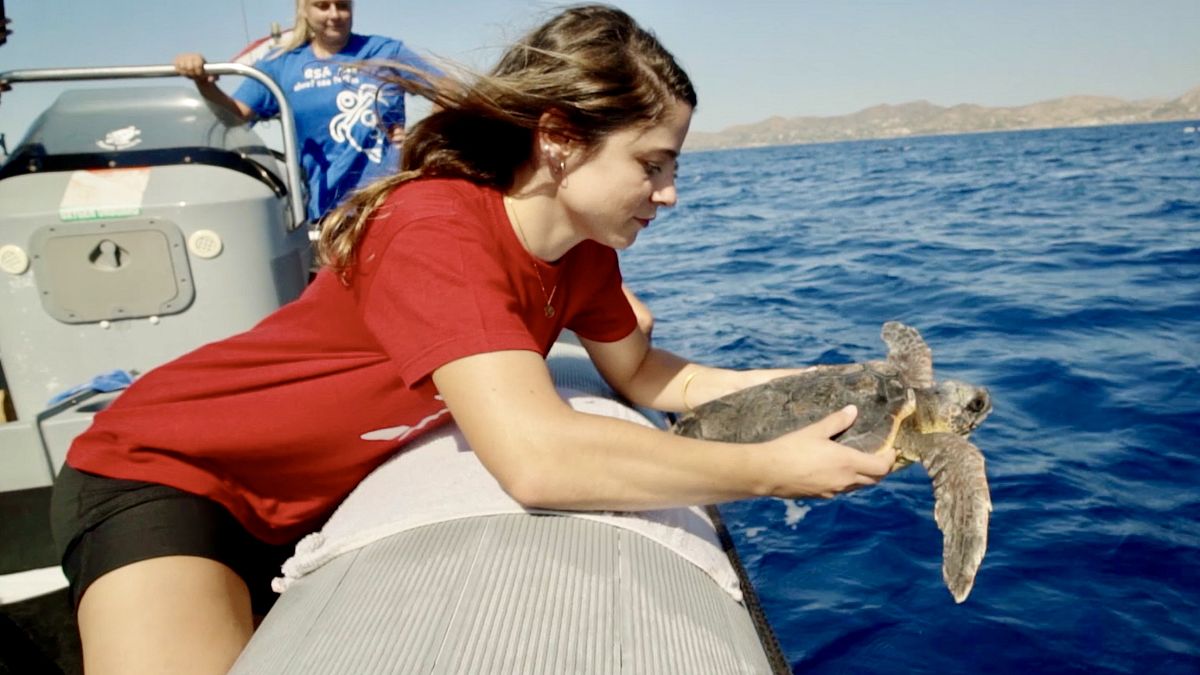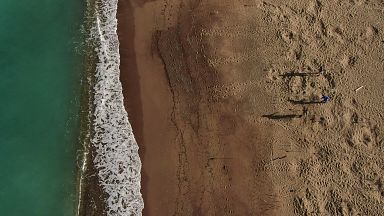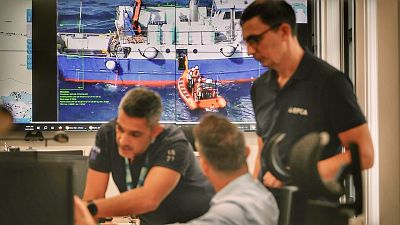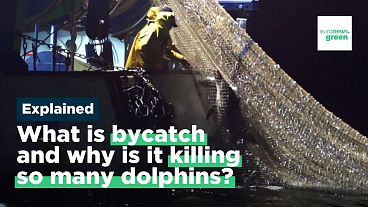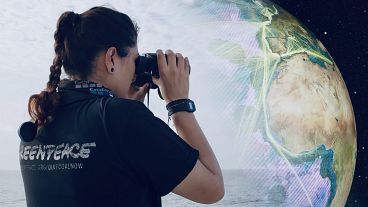Sea turtles and dolphins are protected species, yet they remain under threat. "Ocean" travels to Greece and Italy to meet activists and volunteers who work tirelessly to save these animal lives.
Protecting Turtles
Every morning, just as the sun is rising, teams from the Greek environmental charity ARCHELON survey the beaches of Kyparissia Bay in the west of the Peloponnese.
It is the largest sea turtle nesting area in the whole of the Mediterranean, and most of the nests are along a strip of just 10 kilometres.
And on the area ARCHELON are surveying there are around 5,000 nests along a 12.5 kilometre strip.
They quickly find a turtle trail leading to a new nest. The team carefully examines it and covers it with a metal grid, to protect the eggs from dogs and other threats that come from human activity on the beach.
When ARCHELON started this work, they counted just 600 nests in this area. Now, 40 years later, the turtles are beginning to thrive.
"I'm really into sea turtles! They are this wild animal that dates back to the ages of the dinosaurs, and we still see it coming on these same beaches year and year and year after," says Michalis Souroulidis, ARCHELON's Project Manager for the Western Peloponnese.
Out at sea turtles can get caught up in fishing nets, and sadly their populations wouldn't thrive without human intervention.
"Their biggest threat, their biggest predator is actually human. So in my mind, if we are their biggest threat, then we can also be their biggest help," he adds.
On land at Glyfada, near Athens ARCHELON runs a Sea Turtle Rescue Centre where volunteers help turtles who are sick or who've been injured, which come from all over Greece's long and varied coastlines.
During our visit, we encountered 29 turtles, some of them severely injured: one turtle we see has a head injury and requires an operation. Their treatment requires the expertise of vets, who are assisted by dozens of volunteers from numerous countries.
It's difficult to know for certain how exactly the turtles get injured, but it seems likely that some fishers use force to remove them from their nets when they've got entangled in them. Obviously this can damage their fishing nets and is time consuming, but importantly presence of turtles doesn't affect the size of their catches.
Consequently, one of ARCHELON's main goals is raising awareness: they believe fishers need to understand that sea turtles don't harm their catches and should be treated with care.
"Unfortunately, the number one reason for the majority of the animals that we're receiving is deliberate injuries, mainly in the area of the head. We also usually see scars or injuries in the area of the front flippers," Eirini Kasimati, ARCHELON's Rescue Network and Rehabilitation Officer told Euronews.
"They have been entangled in fishing nets, and in an attempt from the people to get them out, they also hit them. It's, of course, inexcusable. We have cases where sea turtles are entangled in fishing nets, they have ingested hooks or they have ingested fishing line," she added.
The rescue centre welcomes visitors, many of them tourists, and ARCHELON relies on private donations and works with international organisations, including the EU. The turtles can even be "adopted."
Anyone can support a patient through ARCHELON's website by making a donation - public contributions help turtles recover so that they're able to return to the sea.
"A release is always one of the best feelings you can have in this kind of work," Eirini Kasimati said.
Sea turtles are one of a number of slow-growing and long-lived marine species that are causing concern today for their future survival. But there are others, such as dolphins and whales, the cetaceans of the world's seas.
Saving dolphins
"Delfini Del Ponente" is an association in western Liguria that monitors the oceans' mammals and other marine life. Along this stretch of the Italian coast, near the French border, dolphins and whales are particularly abundant. To help preserve and restore these populations, activists meticulously document every sighting. The gathered data identifies areas that might require enhanced protection.
"These coastal creatures live in an area that is greatly impacted by human activities like fishing and boat traffic," Elena Fontanesi, Delfini Del Ponente's Vice President says.
"Among the animals that we identify and monitor, some show marks from collisions with propellers and boat engines. There are animals that have been accidentally captured, or are just showing signs of past interactions that they managed to survive."
Why is this happening? Spanish organisation SUBMON works with local fishermen, and has put cameras on fishing nets in northern Catalonia to see what's going on. And there are similar projects in the Mediterranean and the Black Sea by scientists working with the General Fisheries Commission for the Mediterranean, or GFCM.
Underwater images from one of such cameras in Turkey are showing dolphins trying to pick fish from trawling nets. You can view it in this video uploaded by the UN's Food and Agriculture Organisation.
The revealing footage at at 2 minutes 41 second into the video on Youtube shows dolphins putting themselves in danger as they approach trawled nets to snatch fish, a behaviour termed "depredation." They gnaw at the nets, damaging costly fishing equipment.
Some dolphins even venture into offshore aquafarms, causing distress to the cultivated fish.
In a four-year project, the GFCM and the maritime conservation legal organisation ACCOBAMS evaluated a variety of dolphin deterrents, from acoustic "pingers" to reflective CDs and glass bottles. But they're still not sure how well these methods work.
Mammals get trapped into nets, collide with fishing vessels, and so get injured or stranded- but a prompt intervention can save many of them.
Back on land, on Liguria's Imperia beach, we join a training session of the European project "Life DELFI". One of its objectives is to create a network of rescue teams, comprising various coastal services and animal protection groups, always prepared to assist stranded dolphins.
A group attends a session on how to come to the aid of a stranded dolphin: they are participants from a variety of organisations, and veterinarian Nicola Pussini demonstrates to them - using a dummy dolphin and not a real one - what procedures they can use.
"We are counting around 10-15 stranding situations every year only in the Liguria region," Nicola Pussini, from the Piedmont Experimental Zoo Prophylactic Institute says.
They are learning how to approach a stranded dolphin and what are the first rescue procedures to follow, such as putting them in the shade.
Marine animals in Europe and across the globe are up against increasing challenges — from the effects of fishing to pollution and worsening climate change. But the message is that cetaceans can be saved and even thrive.
"The solutions are here," says Guido Pietroluongo, a conservation veterinarian, University of Padua. "We just need to apply them for the conservation of these extraordinary creatures."
